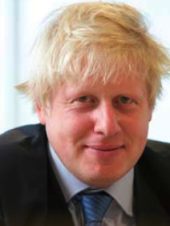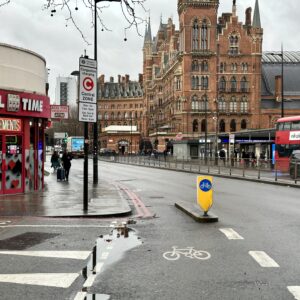[Steve Cardno is the project manager for the London Cycling Network Plus (LCN+) project. After meeting Portland Bureau of Transportation traffic safety specialist Greg Raisman at the recent Velo-City conference, Cardno decided to spend his vacation here to soak up our bike-mosphere. He stopped by our office on Monday for a chat.
I asked him what London is doing to increase bike use, how they are dealing with bike/truck collisions, how their congestion pricing program has impacted biking, and more.]
What’s your role with the City of London?
“I work for the London Borough of Camdem. There are 33 boroughs and Camden is the lead borough for cycling in London. We are project managers for the London Cycling Network Plus (LCN+) project, that is a 900 km bikeway network across greater London. We have been building this project in collaboration with the 33 boroughs and Transport for London (TFL), who are paying for the project, since 2002. The project is due to be completed by the end 2010.”
[Note: Cardno’s work is focused on the network of “borough roads”, which exclude the TFL’s “red routes”. (Red routes are primary, strategic roads that account for 20% of the LCN+.)]
What brings you to Portland?
“I met Greg at the Velo-City conference in Brussels about a month ago. Your Mayor Sam Adams gave a presentation…he told everyone that Portland was the bike capitol of the USA. I was pretty blown away and really, really inspired by it all. Greg invited me over and I think the main selling point was Pedalpalooza. I really just wanted to come over and experience it.
“The main goal was to double the amount of cycling on the network over an eight-year period…and we actually achieved that goal two years earlier than planned.”
I am here to give a presentation at PSU [Portland State University], but I’m also here to learn from you guys, so I’m very keen to find out about bike boulevards. I was really impressed with the floating bikeway on the river [the Eastbank Esplanade]. That was awesome. I’d love to do something like that on our river. I really like your signal crossings as well, and your signal loop detectors for bikes… I’ll be going back to London with ideas like that.”
Where is London right now in its biking evolutionary cycle?

“I would say it’s in a same sort of spot as Portland, although the percentage of trips isn’t as high across London. Our modal share overall is about 3 or 4%. But in central London, the modal share is much higher; in fact, during morning and evening peak periods it’s probably about 12% to 28% depending on where you are in town. So I think London is still climbing, we’re still a “Climber City” [a reference to designations for up-and-coming bike cities at the Velo-City conference] in terms of growth.
There’s a lot of potential in London because of traffic congestion. It’s typically quicker to cycle than it is to use public transit because a cyclist can bypass the queue.”
Is there a goal associated with the network project you’re working on?
“The main goal was to double the amount of cycling on the network over an eight-year period…and we actually achieved that goal two years earlier than planned.”
I hear a lot about problems with lorries (large delivery trucks) in London, are they still a major concern?
“It seems to be, yes. In fact, most of the fatal collisions we have involve lorries (we call them HGVs heavy goods vehicles).” [Cardno said they average about 12 fatal bike crashes a year in London].
What’s being done about the problem?

(Photo: Transport for London)
“I think, slowly, there is a growing awareness of cycling. Education and bike training is becoming better. Instructors are teaching people to ride in the correct part of the road. Traditionally, cyclists have maybe been located too close to the curb line, which can put them at risk when a lorry is turning left and the cyclist is going straight ahead (similar situation to your right-hook incidents that happen here). The bike education programs are helping a lot to teach cyclists to be wary of lorries.
Something else going on in London is a “Share the road” program which I think you have as well. We’re also trying to, as a city, promote special mirrors for lorries, so that drivers can actually see right down the side of the cab and we believe that may help to reduce collisions.” [The mirrors were covered in The Guardian today.]
The City of Portland is set to embark on a congestion pricing pilot program. Since London already has one, can you tell me, as a cyclist, what kind of impact a congestion pricing program might have on my experience?
“The minute they turned the congestion charging scheme on, traffic went down by 25%, which freed up 25% of road capacity… that was given over to buses and cyclists.”
“It had a massive, positive effect on cycling because the minute they turned the congestion charging scheme on, traffic went down by 25%, which freed up 25% of road capacity. A lot of that was given over to buses and cyclists.
Also, the Mayor was very dedicated to putting in enhanced bus lanes wherever possible, they were about 5 meters wide [16.4 feet], which is very good for cyclists as well because cyclists can then overtake a stationary bus.
I think for motor traffic, congestion probably got worse because they had road space taken away from them. Buses, cyclists and pedestrians indeed were benefactors of the scheme.”
Was congestion pricing considered successful?
“It has definitely been considered a success. There is some opposition to it. Basically, on the ground people feel like, ‘why should we have to pay for something that should be our human right — we shouldn’t have to pay to drive into the city’.”
And how did the city respond to that?
“I think the key message was, you have options. If you want to, you can pay the charge [$13/day]. If you don’t want to pay it, you can park and ride, which is still going to cost you. Or, you can cycle, which is free. There are travel options available to everyone.”
What is the funding situation like for bike-specific infrastructure?
“Basically, the LCN+ on borough roads by end of this financial year will have cost £100 million [$163 million USD]. Collectively, about £160 million [$262 million] per year over eight years.
Traditionally, that money has been spent on cycling projects, but in the last 2 or 3 years we’ve started to develop synergies with other traffic engineers; mainly bus priority and road safety programs, because we’ve realized that’s where we can actually deliver our major benefits, which are auto reduction, capacity improvements and speed reduction.
Our new Mayor Boris Johnson has devoted about £60 million [$98 million] a year for cycling, of that £60 million, £10 million [$16 million] is going to the LCN+ project to finish it off.
We’re near the end of our project, but the mayor has started loads of new initiatives [The Guardian newspaper reported that the mayor is “militant” in his support for cycling].
What are those new initiatives your mayor is behind?

an unabashed supporter of
cycling.
(Photo: City of London)
“I think the big flagship one is bike hire — 6,000 public bikes available for hire in the city’s central area. He’s also doing Cycle Superhighways, which, if you think of the LNC+ being like bike boulevards on quiet, backstreet routes, the cycling superhighways are going to be on principal roads. They’re going to be very direct.
We also have our greenways network, which are very quiet routes along on unused railway lines, alongside canals and rivers, through parks, things like that. The Olympic Games are coming to London in 2012 so Transport For London and the Olympic Development Association are developing a cycle and walking route network help pedestrians and cyclists get to the venues.”
That’s a lot of big initiatives. What accounts for that? Is it favorable politics?
“I think cycling has just been growing very steadily in London for the last 5-10 years and with the way the economy is going… and people are looking at the oil situation… I think people are realizing that with global warming and things like that, sometimes they’re better off going by bike.”
What’s one thing that Portland is doing a better job of than London?
“Well, the thing that springs to mind straight away is your bike boxes. We have those in London, we call them advanced stop lines, but in general we don’t use the green surfacing, which raises awareness and makes it stand out. Also, what we don’t do very well in London is actually promote the bike box and educate motor traffic about what they are. I’ve noticed that you have a “wait here” road marking in advance of the stop line and Greg has told me that you have a promotional campaign [which includes a video about them that plays on a loop at the DMV] and literature that you can hand out to drivers. I think that’s really great.
I’ve noticed that you don’t have the enforcement issues that we have. In London we have great trouble with car drivers actually driving into the bike box, which prevents cyclists from getting to the front of the queue. So one of the things I’m taking back with me is some of the promotional literature and I’m going to try and encourage TFL to do some campaign to get the message across better.”
And what’s one thing London is doing that Portland should keep an eye on?
“I think you should try a bike hire. I understand that you’re kind of watching what’s going on in other cities. I’m sure that Portland has a lot of tourism and I think a bike-hire system here would be great.”
It’s interesting to learn more about a European city that is a bit more of a realistic comparison for Portland (at the moment) than Copenhagen or Amsterdam.
It sounds like London is making a solid attempt to be one of the top biking cities in the world. Thanks for sharing your perspectives with us Steve.
Links:
— London Cycle Network
— Transport for London







Thanks for reading.
BikePortland has served this community with independent community journalism since 2005. We rely on subscriptions from readers like you to survive. Your financial support is vital in keeping this valuable resource alive and well.
Please subscribe today to strengthen and expand our work.
i was in London last Spring, and given its history, it’s very difficult to compare the two cities. Street widths are much smaller overall with less room to give to bike lanes than Portland. This often makes for very cramped spaces on London raods and probably could acct for some of the HGV accidents referred to. The biggest transportation improvement in London was the congestion charge. Could that fly in Portland???
Rule, Britannia!
Steve, email me if you’d fancy a pint with an ex-pat and a fellow Englishman’s perspective on the Portland bike scene. It would be great to talk with you more about biking on both sides of the pond.
Great piece, Jonathan.
+2 for “cycling superhighways”. If any mode needs more direct routes, it is biking. Since we are already slower than motor vehicles, having to also go out of our way to find “appropriate” routes is adding insult to injury–unless you’re just out for a ride, then it’s fun to wander around.
I wish we had more cycling-exclusive (read: no peds/dogs, etc., unless there is also a sidewalk) express routes that were wide enough to have at least two bike-size lanes in each direction–or at least two uphill lanes. The Hwy 26 path and/or the Springwater trial (heh, I don’t ride there often, but I hear it can be a ‘trial’ sometimes…) could serve as bike express routes–if they were wide enough and had separate ped facilities. Unfortunately, it seems that the only kind of “Bike paths” we like to create around here are MUPs, which are anything but “bike” paths.
Cycling in London sounds tough alright. From the ‘…Mayor is militant in his support for cycling..’ article (link in story above):
“Of the 15 cyclists who died on the capital’s roads last year, nine were killed in collisions with lorries. In most cases the lorry was turning left and the driver failed to see the cyclist on their inside, according to TfL.
Press reports have so far picked up five cyclists killed by lorries in London this year, according to the London Cycling Campaign.” Helene Mulholland/Guardian UK
Despite that, London really seems to have got the right ideas towards developing the potential the bike can offer for reducing traffic congestion in city situations. The 3 street redesign ‘schemes’ I looked at on the LCN+ seemed like great improvement that were very well done.
I suppose what London’s efforts to improve cycling infrastruce might be showing is what a city can do to reduce congestion if the pressure is great enough. Would London have been able to muster such a support for expansion and improvement of its cycling infrastructure if traffic hadn’t got so bad that the city had to start charging people to bring their motor vehicles into the city?
From what I saw while in London, the streets are not for those with beginner bike skills. Passing clearances between motor vehicles and bikes were routinely less than 1 foot. On the other hand, many of the drivers seemed more skilled than U.S. drivers, and nobody was talking on cell phones while driving. I wonder why that was…oh, yeah, it’s illegal there.
London’s in good hands with Steve on our side. He’s a great guy and he seemed to really enjoy the tour he took with Pedal Bike Tours yesterday. Hopefully he’ll be seen around London wearing our “Portland- America’s Bicycle Capitol” t-shirt! I just hope he’s able to find someone in Portland who can keep up with his Scottish love for beer!
If drivers are passing cyclists within a foot, sounds like cyclists should be taking the lane — and I don’t mean the bike lane. Are cyclists required to use bike lanes that result in such a close passing distance?
As a Londoner who biked in and around central London for 40+ years before moving to Portland in 2002, I went to listen with interest to Steve’s PSU presentation and very much liked what I heard.
A couple of contextual comments relating to previous postings:
The London congestion charge was introduced by the previous mayor, was originally £5/$8, unsuprisingly met with much protest but, as Steve mentioned, created a massive drop in traffic congestion and increase in public transport use. The charge was subsequently increased to £8/$11 and the charge area was expanded westwards.
Steve talked of lower overall commuter bike use than Portland, but that needs to be considered in the context of something like 1.5 to 2 million commuters travelling into the city each day (100% of PDX give or take)and very typical commuter journeys of 20-40 miles each way, which isn’t an over attractive daily proposition even for enthusiastic cyclists. To get around this, large numbers of people leave bikes at stations near their homes, train in and then keep a second runaround bike at central London termini to get to their offices (similar practice in Paris, Munich and many other large euro cities.
After years of London biking in busy traffic (+ several other euro cities), the proximity to cars is still much less of a safety concern to me than it is in Portland. There IS a greater awareness of cars & bikes for each other in Europe; loads of factors, but proximity itself is one, smaller vehicles another. Issues about right/left hooks by trucks/HGVs/lorries is the same everywhere and needs more education on the part of both drivers and cyclists. Exercises like the PDX Water people or LON installation of truck mirrors can only help, but incidents cannot always be attributed to large vehicles. We as bike riders need to appreciate where and when we can be seen and act appropriately – if in doubt, hang back and keep out of the way whether or not you have right of way.
Lastly, here’s to Lord Nelson and his pint offer. I’ve no idea how much longer Steve is here, but I’d be happy to participate/contribute my few pennies/cents worth.
Giant Hogweed post#7.
Despite growth in London cycling in last 10 years and London Cycle Network project, another bit of context for PDXers is that people have been living in what is now London for something like 15,000 years (yes, 3 zeros)and much of the current road system and surrounding infrastructure (including masses of underground transport and utility / service infrastructure) pre-dates introduction of the bicycle 150 years ago. Things have been greatly improved, but it’s far from easy with narrower roads/lanes and building densities….. in short, bike lanes? what bike lanes?